Physical Address
304 North Cardinal St.
Dorchester Center, MA 02124
Fordyce granules are considered benign ectopic sebaceous glands (not associated with hair follicles) that occur on the oral mucosa. A normal variant, they are reported in up to 80% of adults, most commonly on the upper and lower lip and the buccal mucosa. They present as multiple, uniform-sized yellow or yellow-white papules ( Fig. 7.1 ), which may coalesce to form plaques. Usually asymptomatic, patients sometimes describe surface roughness.
Benign ectopic sebaceous glands, considered to be a normal variant
Reported in up to 80% of adults
Present on the upper and lower lip and the buccal mucosa
Sexes equally affected
Less clinically evident in children and adolescents
Asymptomatic, multiple, small yellow papules
Considered a normal variant
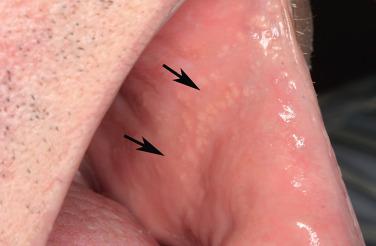
Biopsy reveals normal sebaceous glands near the surface epithelium without hair follicles ( Fig. 7.2 ). Usually, multiple acinar lobules are present, although it may consist of one sebaceous lobule. A central duct sometimes connects the sebaceous lobules to the epithelial surface. Along the periphery, the sebaceous cells are basophilic and cuboidal, while the centrally located cells are polygonal in shape with abundant foamy cytoplasm and a centrally placed nucleus.
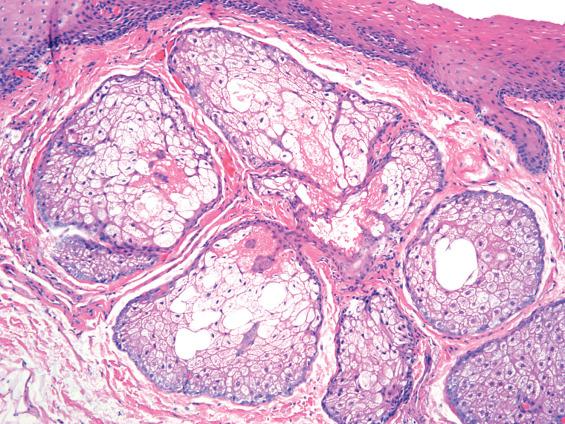
Superficial mucoceles, which can present as 1- to 3-mm papules on the lower lip, generally are blue to clear in color and spontaneously resolve.
No treatment is indicated, although laser ablation can be offered to patients for cosmesis. Tumors arising from Fordyce granules have been reported but are extremely rare.
Amalgam tattoo is a common localized area of blue, gray, or black pigmentation caused by amalgam that has been embedded into the oral tissues during dental procedures. Amalgam is a common material used for dental fillings and contains silver, tin, mercury, and other metals. Amalgam tattoos are most commonly located on the buccal mucosa, gingiva, and alveolar ridge ( Fig. 7.3 ), usually presenting as flat macules, anywhere from a few millimeters to larger, more diffuse areas of pigmentation.
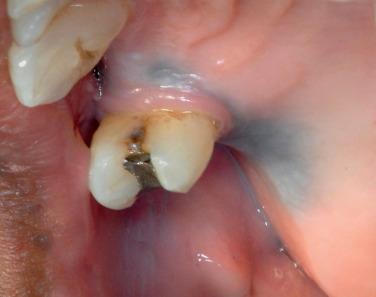
Generally, amalgam tattoos are not visible on dental radiographs. Larger tattoos may be visible on radiographs as densely radio-opaque lesions.
Localized pigmentation caused by amalgam that has been embedded in the oral tissues due to dental procedures
Common
Most common on the buccal mucosa, the gingiva, and the alveolar ridge
Asymptomatic flat macules ranging from a few millimeters to more diffuse areas of blue, gray, or black pigmentation
No treatment necessary unless for cosmetic reasons, or if the clinical diagnosis is uncertain and a melanocytic neoplasia needs to be ruled out
An amalgam tattoo can demonstrate both discrete, fine, black granules and scattered, irregular, solid fragments ( Fig. 7.4 ). Pigment granules are often arranged along collagen fibers and around blood vessels and nerves. Most cases elicit no tissue reaction, although a foreign body, giant cell reaction has been reported in up to 38% of cases.
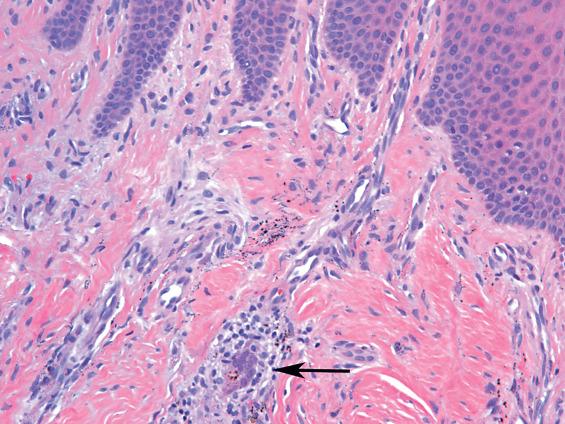
Other exogenous pigmentations can mimic an amalgam tattoo, including graphite, coal dust, and intentional tattooing. Melanin may be present in pigmented nevi, oral melanotic macule, oral melanoacanthoma, and melanoma. Further investigation is warranted if amalgam tattoos occur in sites distant from dental work or if the clinical diagnosis is uncertain.
Discrete, black granules, and/or solid fragment findings of pigment arranged along collagen fibers, around blood vessels and nerves
Foreign body reaction reported in up to 38% of cases
Other exogenous sources of pigmentation including pencil graphite, intentional tattoos, and coal dust
No treatment is generally required, unless for cosmetic reasons (surgery or laser treatment) or if the clinical diagnosis is uncertain and a melanocytic neoplasm needs to be ruled out.
Ectopic thyroid is a result of the abnormal migration of the thyroglossal duct from the foramen cecum located at the junction of the anterior two-thirds and posterior third of the tongue to its normal prelaryngeal location. While uncommon, nearly 90% of all ectopic thyroids are located on the tongue between the foramen cecum and the epiglottis. In > 70% of patients with lingual thyroid, this is the only functioning thyroid tissue. Females are affected four to seven times as frequently as males. Symptoms, including dysphagia, dyspnea, globus sensation, and dysphonia, most often coincide with puberty onset, pregnancy, or menopause corresponding to elevated thyroid-stimulating hormone (TSH). Thyroid function tests should be evaluated as part of the workup. The endoscopic appearance at the base of the tongue is of a hyperemic mass ( Fig. 7.5 ).
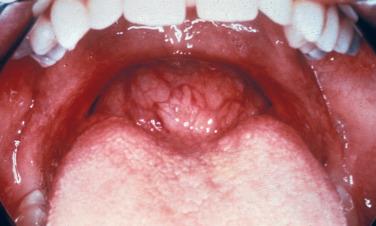
The iodine content of the thyroid tissue results in very high signal attenuation in relation to surrounding soft tissue using computed tomography. Radioisotopic studies ( 131 Iodine and/or 99m Tc: technetium-99m pertechnetate) may be needed to determine size, location, and activity of thyroid tissue.
Rare developmental anomaly due to the abnormal migration of the thyroid gland from the base of the tongue
Uncommon, with reported incidence of 1/100,000
90% of ectopic thyroids are lingual thyroids
Larger lesions can cause airway obstruction
Rare reports of carcinoma development
Females > > > males (4-7 : 1)
All ages (mean, 44 years)
Dysphagia, dyspnea, dysphonia, globus sensation
One-third of patients are hypothyroid
In > 70%, ectopic tissue is only functional thyroid tissue
Euthyroid and asymptomatic patients only require periodic follow-up
Suppression therapy with thyroxine to reduce size and symptoms
Radioactive 131 I ablation
Autotransplantation of lingual thyroid
Immediately below the intact surface mucosa, unencapsulated ectopic thyroid follicles containing colloid and lined by cuboidal epithelium are identified, insinuating between the tongue musculature ( Fig. 7.6 ). Lymphocytic thyroiditis and adenomatoid nodules, as well as papillary thyroid carcinoma, have been reported.
Unencapsulated normal thyroid tissue insinuated through skeletal muscle
Lymphocytic thyroiditis and adenomatoid nodules may develop
Metastatic thyroid carcinoma
Positive cytoplasmic staining with thyroglobulin, epithelial membrane antigen, and low-molecular weight cytokeratin
Positive nuclear staining with TTF-1
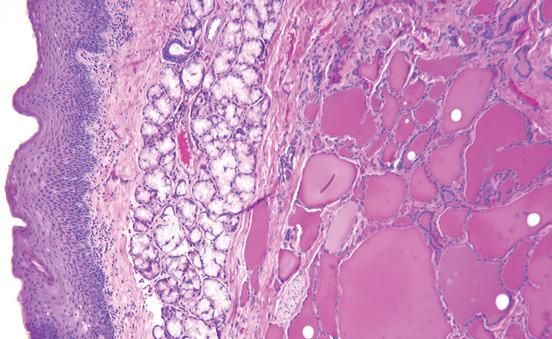
Fine needle aspiration biopsy can be used to confirm the diagnosis of ectopic thyroid or to rule out neoplastic changes.
There are a number of clinical differential diagnostic considerations (hemangioma, lymphangioma, hypertrophic lingual tonsils, abscess, mucus retention cyst, squamous cell carcinoma), but the histologic features of ectopic thyroid are pathognomonic.
Thyroxine suppresses TSH with a subsequent reduction in size. Surgery is used if there is uncontrollable hemorrhage, airway obstruction, or inability to eat. Radioablation may be used in nonsurgical candidates. If no “normal” thyroid is identified in the anterior neck, autotransplantation can be performed. Malignancy is a rare complication (< 1%), although it is more common in men.
Oral hairy leukoplakia (OHL) is a benign epithelial disease associated with Epstein-Barr virus (EBV) and nearly always identified in human immunodeficiency virus (HIV)-infected and/or immunocompromised patients. The disease correlates with viral load and CD4 counts. OHL usually presents on the lateral border of the tongue as a white plaque, or vertical streaks, or with a corrugated surface ( Fig. 7.7 ). The lesions can become quite extensive, and in some cases cover the entire lateral and dorsal tongue. The lesion is asymptomatic and cannot be rubbed off.
Benign, asymptomatic epithelial hyperplasia associated with Epstein-Barr virus nearly always in immunocompromised patients
Less than 10% of HIV-infected patients who are on highly active antiretroviral therapy
Non-HIV associated OHL reported in solid-organ transplant recipients and less commonly in patients with hematologic malignancies, autoimmune diseases, and other systemic inflammatory conditions
OHL reported in immunocompetent patients on long-term inhaled, topical, and systemic corticosteroid use
Primarily occurs on the lateral tongue, unilaterally or bilaterally
Identified particularly in HIV-positive men
No racial or age predilection
White patches that can have a corrugated or folded surface that cannot be rubbed off
May be quite extensive and bilateral and involve dorsal tongue
10% improve spontaneously
No specific treatment, although secondary Candida may need to be treated
HIV , Human immunodeficiency virus; OHL , oral hairy leukoplakia.
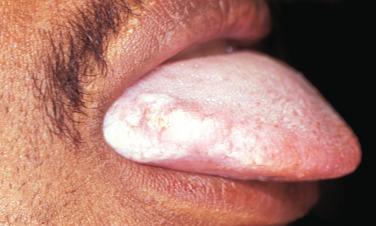
OHL is characterized by marked epithelial acanthosis with elongation of the rete ridges and prominent hyperkeratosis. In the superficial spinous layer, “balloon cells,” characterized by intracellular ballooning degeneration, nuclear clearing, and margination of the chromatin indicative of a viral cytopathic effect, are present ( Fig. 7.8 ). These nonspecific findings require documentation of EBV within the lesion.
Epithelial hyperplasia, hyperparakeratosis, and acanthosis
Balloon cells in the upper spinous layer
Viral cytopathic effect can sometimes be seen
Little or no inflammation
Secondary candidal infection may be identified
Markers for Epstein-Barr virus antigens (EBER) show punctate nuclear staining in the balloon cells
Become a Clinical Tree membership for Full access and enjoy Unlimited articles
If you are a member. Log in here